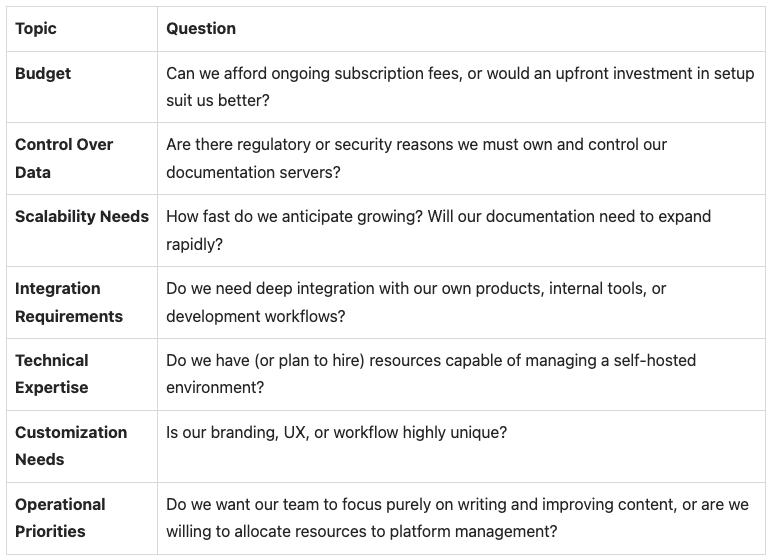Self-hosted vs. SaaS documentation platforms: What’s best for your product?
Choosing the right documentation platform is a strategic decision, one that can influence your product’s scalability, security posture, user experience, and even operational costs. In today’s documentation hosting landscape, two dominant models have emerged: self-hosted and SaaS-based documentation platforms. Both have their strengths and trade-offs. And the right choice depends on your organization's resources, priorities, and long-term vision.
In this blog, we’ll break down the nuances of each approach, provide side-by-side comparisons, and equip you with a checklist to evaluate your needs, so you can make a decision that’s truly aligned with your product and growth trajectory.
Understanding the Platforms
What is a SaaS Documentation Platform?
A SaaS (Software-as-a-Service) documentation platform is a cloud-based solution where all infrastructure, maintenance, scaling, and security responsibilities are handled by the vendor. You simply sign up, configure your space, and start documenting.
Examples: GitBook, Document360, Helpjuice, Zendesk Guide
Key Features:
Rapid setup
Automatic updates and patches
Collaboration tools built-in
Scalability managed by the provider
According to a 2023 report by Gartner, 74% of enterprises rely on SaaS solutions for at least part of their digital infrastructure, citing speed and reduced maintenance as key drivers.
What is a Self-Hosted Documentation Platform?
A self-hosted documentation platform means you control the environment. You set up your own servers (cloud or on-premises), install the necessary software, and manage the entire documentation infrastructure yourself.
Examples:
Docusaurus, MkDocs, Sphinx (often deployed over AWS, Azure, or internal servers)
Markdown-based repositories like GitHub Pages or custom static site generators
Key Features:
Full control over hosting and customization
Direct management of security and compliance
No vendor lock-in
Higher upfront technical complexity
A survey by Stack Overflow in 2023 found that 32% of tech startups prefer self-hosted systems for critical internal tools to maintain control over data and flexibility.
Comparison
Remember: Neither model is universally "better." It depends deeply on your organizational maturity, technical capacity, and strategic needs. This table offers a framework to help you navigate this decision better.
At a large-scale enterprise where I previously worked, our technical documentation team used a SaaS platform. Think of it as living in a sleek apartment complex where maintenance, upgrades, and security were all handled by a professional management company.
Benefits we enjoyed:
Effortless Scalability: As new products and features launched rapidly, the SaaS platform scaled instantly.
Reduced Operational Overhead: Our team focused solely on writing, not on servers, backups, or compliance patches.
Global Collaboration: Distributed teams collaborated seamlessly in real time.
But there were trade-offs:
Limited Customization: Deep integrations with some of our internal bespoke tools were clunky.
Data Control: Sensitive data was ultimately in a third-party environment.
Recurring Costs: Subscription fees added up, although justified by the convenience.
Fast forward to my current role at a burgeoning startup, where the landscape is vastly different. We use a self-hosted, docs-as-code approach with Markdown files in GitHub and deploy via our own cloud infrastructure. It's like building and managing our own customized home.
Advantages we now enjoy:
Unfettered Customization: Tailored workflows and branding.
Cost-Effectiveness: After the initial setup, infrastructure costs are optimized.
Direct Data Control: Compliance and data privacy are fully managed in-house.
However, it’s not without challenges:
Technical Expertise Required: Setting up, maintaining, and troubleshooting are in our court.
Proactive Scalability Planning: We have to anticipate and provision resources for growth.
Emerging Trends: Docs-as-Code and Headless CMS
As documentation practices evolve, two approaches are influencing both SaaS and self-hosted models:
1. Docs-as-Code
Treat documentation like code: version-controlled, collaborative, and embedded into development workflows.
Typically uses Markdown, Git repositories, CI/CD pipelines for deployment.
Ideal for agile, dev-centric organizations.
In a 2022 survey by The Content Wrangler, 67% of companies adopting docs-as-code reported faster documentation cycles and improved collaboration between developers and writers.
2. Headless CMS
A content management system that provides content via APIs without dictating the front-end display.
Allows maximum flexibility: you can pull content into websites, mobile apps, IoT devices, or documentation portals.
SaaS headless CMS examples: Contentful, Strapi.
Both approaches allow for modularity, scalability, and cross-platform content delivery, a major plus for modern product teams.
Who Should Choose What?
SaaS Platforms are Ideal for:
Fast-growing startups that prioritize speed over heavy customization.
Enterprises that need global collaboration without investing heavily in infrastructure.
Teams with limited in-house IT expertise for server management.
Self-Hosted Platforms are Ideal for:
Tech-savvy startups wanting full control and lower long-term costs.
Companies with strict compliance needs (finance, healthcare, defense).
Products needing deep customization and tight integration with internal systems.
Checklist: Evaluate Your Documentation Needs
Before deciding, ask yourself:
If most of your answers lean toward ease, speed, and reduced operational load, a SaaS platform might serve you best.
If your answers lean toward control, customization, and strategic autonomy, self-hosting could be your winning move.
A Note on the Content Development Cycle (CDC) Philosophy
At DTALES Tech, we operate with the Content Development Cycle (CDC) philosophy, an iterative, data-driven process where documentation evolves alongside the product itself. With CDC, we focus on maintaining and growing your documentation to meet real user needs, based on data, stakeholder input, and continuous feedback, irrespective of your choice of documentation platform.
In today's competitive environment, documentation is not just user support; it's a powerful extension of your product experience. And choosing between a self-hosted and SaaS documentation platform is not a one-time technical decision, as it reflects how your company prioritizes control, budget, security, scale, and team capabilities.
Whichever model you pick, the real differentiator will be how thoughtfully and systematically you maintain and evolve your documentation ecosystem.
Choose wisely. Build intentionally. Document brilliantly.
#SaaSDocumentation #SelfHostedDocs #TechnicalDocumentation #DocumentationPlatforms #TechDocs #DocsAsCode #HeadlessCMS #ContentStrategy #KnowledgeBase #ProductDocumentation #TechStack

